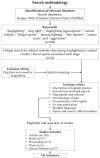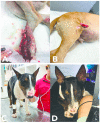The Welfare of Fighting Dogs: Wounds, Neurobiology of Pain, Legal Aspects and the Potential Role of the Veterinary Profession
- PMID: 36077977
- PMCID: PMC9454875
- DOI: 10.3390/ani12172257
The Welfare of Fighting Dogs: Wounds, Neurobiology of Pain, Legal Aspects and the Potential Role of the Veterinary Profession
Abstract
Throughout history it has been common to practice activities which significantly impact on animal welfare. Animal fighting, including dogfighting, is a prime example where animals often require veterinary care, either to treat wounds and fractures or to manage pain associated with tissue and where death may even result. Amongst the detrimental health effects arising are the sensory alterations that these injuries cause, which not only include acute or chronic pain but can also trigger a greater sensitivity to other harmful (hyperalgesia) or even innocuous stimuli (allodynia). These neurobiological aspects are often ignored and the erroneous assumption made that the breeds engaged in organized fighting have a high pain threshold or, at least, they present reduced or delayed responses to painful stimuli. However, it is now widely recognized that the damage these dogs suffer is not only physical but psychological, emotional, and sensory. Due to the impact fighting has on canine welfare, it is necessary to propose solution strategies, especially educational ones, i.e., educating people and training veterinarians, the latter potentially playing a key role in alerting people to all dog welfare issues. Therefore, the aim of this review is to describe the risk factors associated with dogfighting generally (dog temperament, age, sex, nutrition, testosterone levels, environment, isolation conditions, socialization, education, or training). A neurobiological approach to this topic is taken to discuss the impact on dog pain and emotion. Finally, a general discussion of the format of guidelines and laws that seek to sanction them is presented. The role that veterinarians can play in advancing dog welfare, rehabilitating dogs, and educating the public is also considered.
Keywords: animal fight; dog aggression; dog fight; dog welfare; illegal sports; pain.
Conflict of interest statement
The authors declare no conflict of interest.
Figures






Similar articles
-
Relationship Between Scarring and Dog Aggression in Pit Bull-Type Dogs Involved in Organized Dogfighting.Animals (Basel). 2016 Nov 15;6(11):72. doi: 10.3390/ani6110072. Animals (Basel). 2016. PMID: 27854270 Free PMC article.
-
Pain sensitivity differs between dog breeds but not in the way veterinarians believe.Front Pain Res (Lausanne). 2023 Jun 26;4:1165340. doi: 10.3389/fpain.2023.1165340. eCollection 2023. Front Pain Res (Lausanne). 2023. PMID: 37435196 Free PMC article.
-
Lead pulling as a welfare concern in pet dogs: What can veterinary professionals learn from current research?Vet Rec. 2022 Nov;191(10):e1627. doi: 10.1002/vetr.1627. Epub 2022 May 12. Vet Rec. 2022. PMID: 35546517 Review.
-
Reporting of suspected dog fighting to the police, Royal Society for the Prevention of Cruelty to Animals and equivalents by veterinary professionals in the UK.Vet Rec. 2018 Nov 10;183(18):567. doi: 10.1136/vr.104753. Epub 2018 Oct 24. Vet Rec. 2018. PMID: 30355589
-
Dog Tethering in Slovakia: Legal, Ethical and Behavioral Aspects and Dog Welfare Implications.Animals (Basel). 2021 Feb 24;11(3):594. doi: 10.3390/ani11030594. Animals (Basel). 2021. PMID: 33668273 Free PMC article. Review.
Cited by
-
How does chronic pain impact the lives of dogs: an investigation of factors that are associated with pain using the Animal Welfare Assessment Grid.Front Vet Sci. 2024 Apr 4;11:1374858. doi: 10.3389/fvets.2024.1374858. eCollection 2024. Front Vet Sci. 2024. PMID: 38638643 Free PMC article.
-
The Impact of the Social Determinants of Human Health on Companion Animal Welfare.Animals (Basel). 2023 Mar 21;13(6):1113. doi: 10.3390/ani13061113. Animals (Basel). 2023. PMID: 36978653 Free PMC article. Review.
-
Case report: First criminal conviction of dog fighting in Brazil: an international network organization.Front Vet Sci. 2024 Jan 8;10:1327436. doi: 10.3389/fvets.2023.1327436. eCollection 2023. Front Vet Sci. 2024. PMID: 38260207 Free PMC article.
-
Euthanasia and Pain in Canine Patients with Terminal and Chronic-Degenerative Diseases: Ethical and Legal Aspects.Animals (Basel). 2023 Apr 6;13(7):1265. doi: 10.3390/ani13071265. Animals (Basel). 2023. PMID: 37048521 Free PMC article. Review.
References
-
- Yilmaz O., Coskun F., Ertugrul M. Human factor in dog fighting. J. Vet. Adv. 2015;5:853. doi: 10.5455/jva.20150421012656. - DOI
-
- Yilmaz O. Dog fighting in some european countries. Int. J. Livest. Res. 2016;6:20. doi: 10.5455/ijlr.20161204114048. - DOI
-
- Evans R.D., Forsyth C.J. Dogmen: The rationalization of deviance. Soc. Anim. 1998;6:203–218. doi: 10.1163/156853098X00159. - DOI
Publication types
LinkOut - more resources
Full Text Sources

